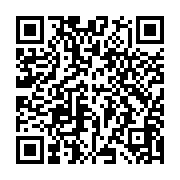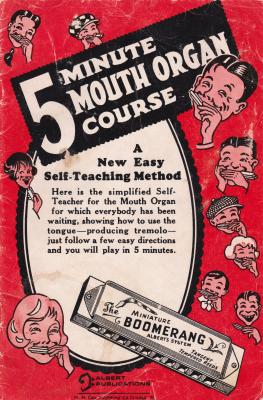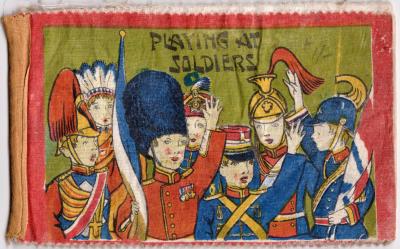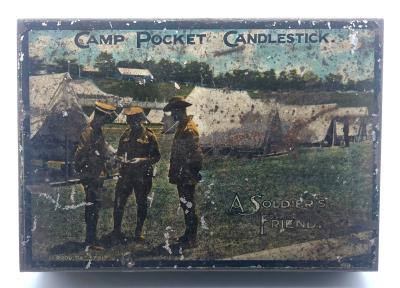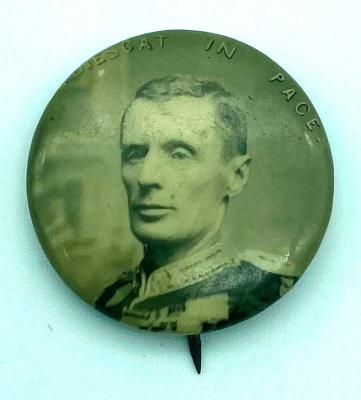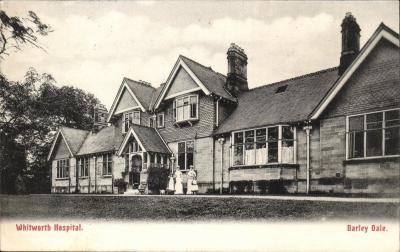'The Miniature Boomerang' mouth organ
c. 1925'The Miniature Boomerang' mouth organ in its original box. The mouth organ is made from a silver metal (chromed brass) on either side of a rectangular, deep red Bakelite piece with ten holes containing the reeds needed to make the sound.
The writing on the upper metal section reads 'The Miniature Boomerang, Albert's System, Tangent tempered reeds'. An image of a hand throwing a boomerang is on the left of the writing, and a floral decoration on the right.
There is a triangular metal piece at either end which has a screw which goes through the Bakelite section and is held by a nut on the lower side.The screw and nut on the right hand side are replacements.
On one triangle, it reads 'Made in Germany' and on the other 'A-440', relating to the original factory "tempered" tuning, to A440Hz.
On the lower metal surface is a 'C' which is the key of the instrument.
The box is deep burgundy in colour. The writing on the top of the box is in gold. The inside of the box (both top and bottom) is in a lighter red colour. The bottom contains information about care and maintenance of the mouth organ. The underside of the box is cream in colour and has a green, diamond shaped label giving manufacturing details.
According to 'The Powerhouse Collection: "The J Albert and Son 'Boomerang' mouth organ was an iconic Australian musical instrument during the late nineteenth century and throughout much of the twentieth century.
Being compact, portable, tuneful and cheap, it became immediately popular with the Australian public upon its release onto the market in 1897.
From their introduction the instrument remained popular, supporting a notion of Australian identity, bolstered by broader national concerns such as Federation in 1901 and later, World War One.
Being pocket sized, mouth organs generally became a popular instrument amongst Australian soldiers providing a welcome distraction to the rigours and tedium of war.
Ironically most mouth organs including the 'Boomerang' were made by German manufacturers such as CA Seydel and Son of Klingenthal in Saxony, who manufactured the 'Boomerang' mouth organs for Alberts".
Details
Details
On mouth organ upper metal surface:
"The MINIATURE
BOOMERANG
ALBERT'S SYSTEM
TANGENT
TEMPERED REEDS."
On left hand end:
"MADE IN
GERMANY"
On right hand end:
"A-440"
On mouth organ lower metal surface:
"C"
On lid of box:
"The Miniature
BOOMERANG
Tangent Tempered Reeds
Albert's System MADE IN GERMANY"
Information in bottom of box lid:
"MOST IMPORTANT TO YOU
FOUR "DONT'S" FOR BOOMERANG MOUTH ORGAN PLAYERS"
DONT play your BOOMERANG MOUTH ORGAN after
eating Fruit, Sweets or Food, as particles of same are
liable to corrode and clog the Reeds and Reed Plates.
DON'T bend your head downwards when playing the
Mouth Organ; always rather hold your head tilted a little
towards the back. In this way, you will prevent saliva
entering the Mouth Organ.
DON'T forget, after playing your "BOOMERANG" to always hit the
Mouth Organ with the Reed Holes downwards, on your open hand,
to shake out any excessive moisture, which, if left in the Mouth
Organ, causes corrosion.
DON'T abuse your little Musical Companion; when you finish playing,
put same in its box, to prevent fluff or foreign matter finding its way
into the holes, thus choking the Reeds and preventing the notes
from playing properly.
WE CANNOT GUARANTEE BOOMERANG MOUTH ORGANS
AGAINST MISUSE OR ABUSE. THE HUMAN ELEMENT WILL
ALWAYS BEAT US"
"THE RETURN OR EXCHANGE OF THIS MOUTH ORGAN IS FORBIDDEN BY SANITARY LAWS FOR HYGIENIC REASONS"
"Printed in Germany"
On label on underside of box:
"GENUINE
BRASS
REEDPLATES & COVERS
MADE IN GERMANY"
Other items from Recollections of War
- '5 Minute Mouth Organ Course' booklet, 1926
- WWI era children's cloth book - 'Playing at Soldiers'
- Cardboard dove from Brisbane Peace Procession - WWI
- 'A Soldier's friend' - Camp Pocket Candlestick
- Engraved snuff box made from horn
- Boer War Memorial pin - Major-General Andrew Wauchope CB, CMG, Order of Medijieh
- Post-WWI medallion issued to Driver L.A. Modra
- 'Canine Defence' tag issued to MacTavish
- WWI trench watch presented to Harold Evans Barnett
- Metal identification label - Keith Neville Leek, R.A.N.R.
- British Red Cross Society medallion presented to Catherine M. Topham, 1913
- Postcard of Whitworth Hospital, Darley Dale, Derbyshire
Scan this QR code to open this page on your phone ->
